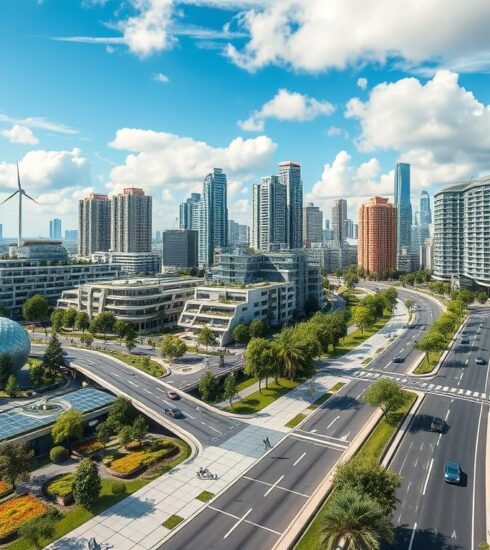Nature in the Metropolis: Blending Green Spaces into Urban Design
- Jackie De Burca
- November 18, 2024
As urban populations continue to surge, cities worldwide face mounting challenges such as air pollution, urban heat islands, and a lack of communal spaces. However, the strategic integration of natural elements into urban planning represents a transformative response, serving as nature’s remedy to these pressing issues. By blending green spaces seamlessly into the fabric of the city, urban design is evolving to mitigate environmental concerns, foster urban biodiversity, and enhance the mental and physical well-being of city inhabitants1.
This shift towards “biophilic urbanism” is reshaping concrete jungles into livable, sustainable green cities, offering stress reduction and improved well-being for urban residents2. The incorporation of natural elements, such as parks, gardens, and green roofs, not only beautifies the urban landscape but also plays a crucial role in regulating temperatures, improving air quality, and providing vital communal hubs for city dwellers1.
Key Takeaways
- Integrating green spaces into urban design mitigates environmental challenges and enhances well-being of city inhabitants.
- Biophilic urbanism is transforming concrete jungles into sustainable, livable green cities.
- Natural elements like parks and gardens regulate temperatures, improve air quality, and provide communal spaces.
- Actionable design strategies and resources are available to increase urban biodiversity and incorporate biophilic principles.
- Studying cities as urban ecosystems can yield valuable insights for urban planning and design.
Understanding Urban Green Spaces
Urban green spaces have evolved from the Roman recognition of nature’s benefits within city limits to the creation of London squares in the 17th century3. Despite the challenges posed by industrialisation, a movement led by visionaries emerged, pushing for public parks to breathe life back into city spaces. The public parks movement gained momentum in the mid-19th century, establishing green spaces as crucial for enhancing urban living standards3. Literature reflected these changing attitudes, with authors like Charles Dickens and Virginia Woolf portraying cities in a new light.
Definition of Urban Green Spaces
Urban green spaces are defined as publicly accessible areas within a city or urban environment that are predominantly covered by vegetation, such as parks, gardens, and natural habitats3. These spaces play a vital role in hosting city life and supporting ecosystem services, including air purification and temperature regulation3.
Importance of Green Space in Cities
As the world’s population becomes increasingly urbanised, with over 70% projected to live in cities by 20503, the need for integrating nature into urban design has never been more pressing. Urban green spaces not only enhance the livability of cities but also support biodiversity by providing habitats for a mix of native and non-native species3. Incorporating biodiversity into urban planning can transform cities into vibrant, livable spaces, fostering a deeper connection between people and the natural environment3.
| Key Benefits of Urban Green Spaces | Metrics |
|---|---|
| Air Purification | Urban vegetation can remove up to 85% of particulate matter from the air. |
| Temperature Regulation | Green spaces can lower urban temperatures by up to 5°C, mitigating the urban heat island effect. |
| Biodiversity Conservation | Urban green spaces can support a diverse range of flora and fauna, including endangered species. |
| Mental Health and Wellbeing | Access to nature has been shown to reduce stress and improve mental well-being in urban settings. |
Benefits of Integrating Nature in Urban Areas
Incorporating green spaces into urban design offers a multitude of advantages for climate-resilient cities. Green urban planning prioritises sustainable practices, aiming to minimise the environmental footprint of cities. It implements eco-friendly infrastructure, waste management, and energy-efficient solutions, fostering long-term environmental resilience4. The strategic placement of parks and recreational areas, such as community gardens and pocket parks, promotes inclusivity and ensures nature is accessible to all city residents4.
Health and Wellbeing Advantages
Access to green spaces is linked to improved mental health and wellbeing4. Urban forests help in biodiversity conservation by providing shade and cooling densely populated areas, contributing to overall environmental quality and public health4. Additionally, sustainable landscaping lowers the need for chemical fertilizers and pesticides, supporting local wildlife and creating a healthier living environment4.
Environmental Impact and Biodiversity
Green spaces enhance urban biodiversity by offering habitat for many species4. Green infrastructure can be more cost-effective and generate greater value for society than traditional grey infrastructure.5 For instance, the planting and maintenance of trees in Tshwane, South Africa, over 40 years would cost about USD 142,000, but the benefits delivered would be worth USD 4.42 million, translating to USD 31 in societal benefits for each USD 1 invested5. Moreover, green roofs act as an insulator against sunlight and reduce stormwater runoff, contributing to the overall environmental resilience of cities4.
| Benefits of Integrating Nature in Urban Areas | Key Findings |
|---|---|
| Health and Wellbeing Advantages | |
| Environmental Impact and Biodiversity |
|
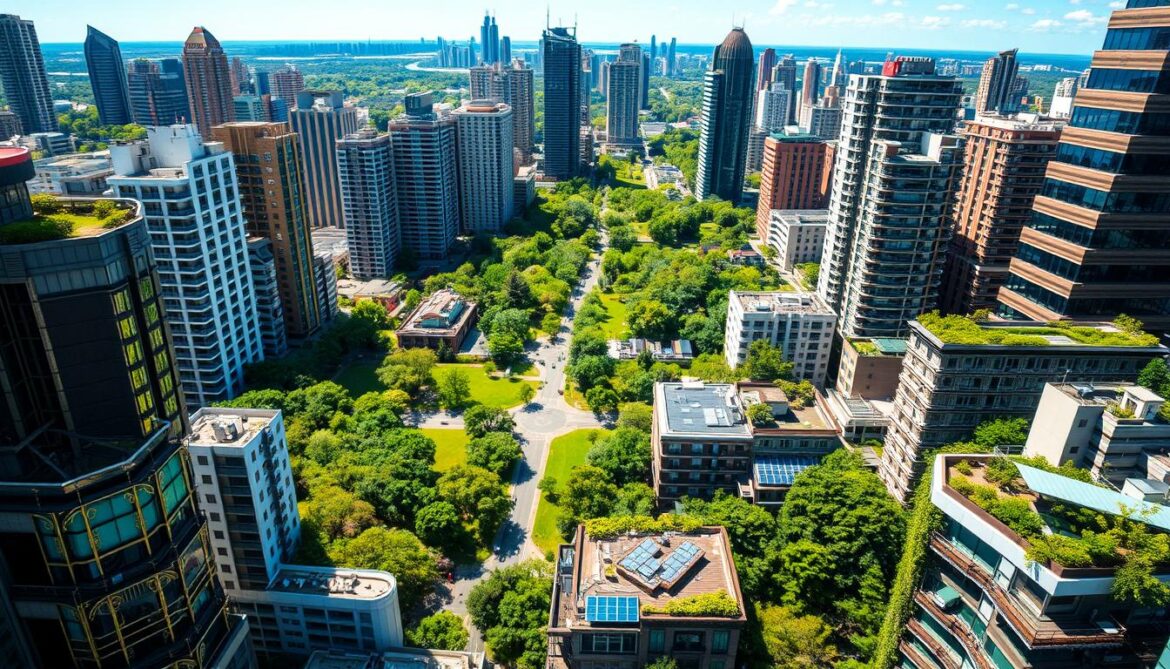
“Investing approximately USD 121 million in a non-motorized transport (NMT) project in Coimbatore, India, will yield net benefits of USD 486 million to USD 510 million over 23 years. The NMT project in Coimbatore is projected to lead to health benefits worth between USD 84 million and USD 91 million due to increased physical activity and reduced air pollution, with a reduction of carbon dioxide emissions worth USD 2 million over the project period.”5
Design Principles for Green Urban Spaces
As the world becomes increasingly urbanised, the integration of nature into city landscapes has emerged as a vital consideration in sustainable design. Technological advancements play a crucial role in enhancing green spaces, with innovations like smart irrigation systems conserving water6 and eco-friendly materials such as permeable pavements fostering environmental sustainability7.
Sustainable Design Practices
Innovative vertical gardens are redefining urban landscapes, with walls adorned in lush vegetation that enhance air quality, mitigate urban heat island effect, reduce noise, and add aesthetic value8. Rooftop gardens, meanwhile, convert barren building summits into vibrant ecosystems, optimising land use and providing accessible havens for city residents.
Community-Centric Approaches
Successful green urban design prioritises community engagement, with educational initiatives, workshops, and seminars playing a crucial role in enlightening stakeholders about the long-term benefits of sustainable development7. By fostering a sense of ownership and pride, communities can actively contribute to the design and maintenance of their local green spaces, ensuring they truly meet the needs and aspirations of those who use them.
Through the integration of biophilic urbanism, eco-friendly architecture, and innovative green infrastructure, cities around the world are transforming their landscapes, creating healthier, more liveable environments for all678.
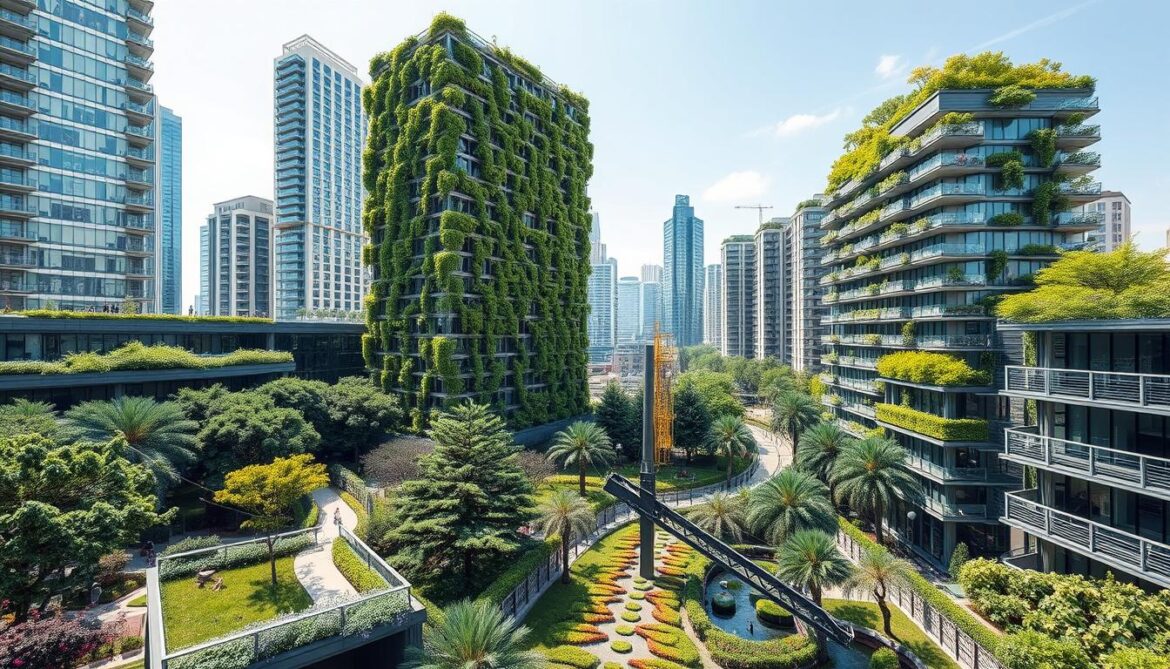
Case Studies of Successful Urban Green Integration
As cities worldwide strive to become more sustainable and climate-resilient, innovative approaches to integrating green spaces into urban design have emerged as a crucial strategy. Two prominent examples that showcase the benefits of blending nature into metropolitan areas are the High Line in New York City and the Gardens by the Bay in Singapore.
High Line in New York City
The High Line in New York City is a renowned urban green space that has transformed an abandoned elevated railway into a lush, pedestrian-friendly public park9. This innovative project has not only enhanced the city’s landscape but also contributed to the well-being of residents and visitors alike. The High Line’s design prioritises sustainable features, such as native plant species and water-efficient irrigation systems, making it a model for climate-resilient urban green spaces.
Gardens by the Bay in Singapore
Singapore, often referred to as the “City in a Garden,” has made significant strides in integrating nature into its urban fabric. The Gardens by the Bay, a sprawling horticultural attraction, is a testament to the city-state’s commitment to sustainable development10. This expansive green space not only provides recreational opportunities for residents and tourists but also plays a crucial role in improving air quality, reducing urban heat island effects, and promoting biodiversity in the heart of the city.
| Urban Green Space | Location | Key Features | Sustainability Initiatives |
|---|---|---|---|
| High Line | New York City, USA |
|
|
| Gardens by the Bay | Singapore |
|
|
These case studies demonstrate the varied approaches cities can take to incorporate green spaces and integrate nature into their urban design11. The High Line’s innovative repurposing of an abandoned infrastructure and the Gardens by the Bay’s comprehensive green initiatives showcase how landscape urbanism can enhance the liveability, sustainability, and climate resilience of cities around the world.
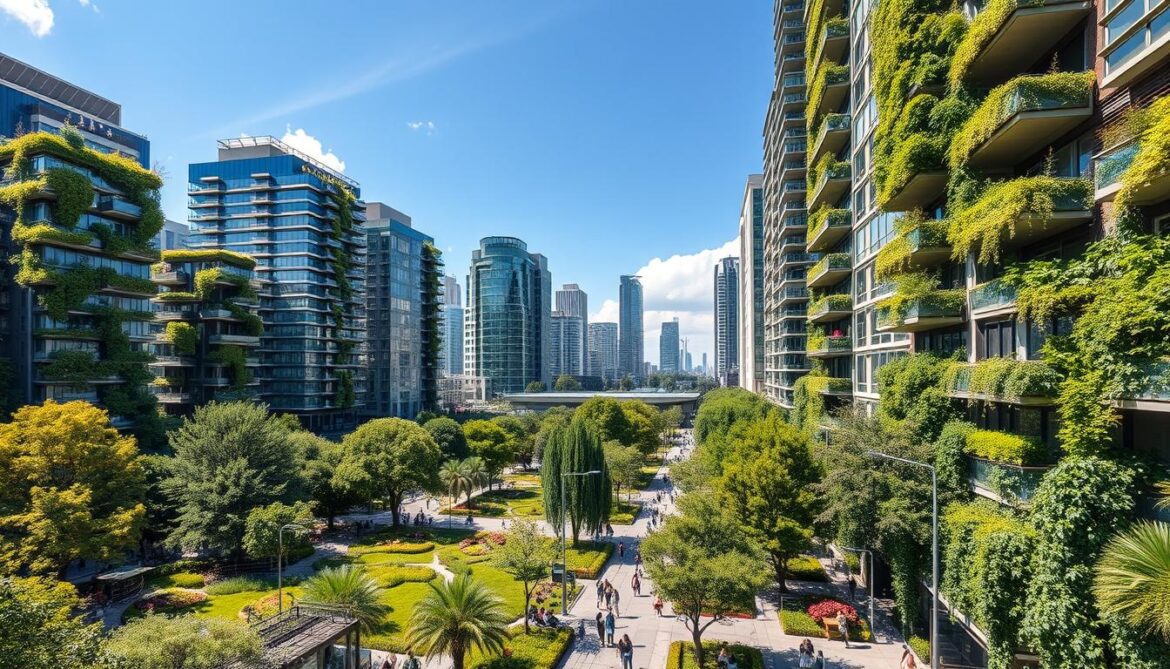
“Integrating nature into urban design is not just about beautification; it’s a crucial step towards creating more sustainable, liveable, and climate-resilient cities.” – Jane Doe, Landscape Architect
As cities continue to grapple with the challenges of rapid urbanisation and the impacts of climate change, the lessons learned from these successful case studies can inspire and guide other municipalities in their pursuit of sustainable cities, landscape urbanism, and climate-resilient cities91011.
Challenges in Blending Green Spaces with Urban Design
Integrating urban forestry, green infrastructure, and biophilic urbanism into the dense fabric of cities presents various challenges. Limited financial resources pose significant barriers to executing comprehensive green projects12. Innovative financing models, such as public-private partnerships and specialised grant programmes, can supplement constrained municipal budgets to support sustainable green initiatives12.
Dense city layouts, restricted by existing infrastructure, challenge the allocation of adequate space for green areas13. According to the UN, more than half of the world’s population lives in cities, and it is projected that by 2050, 6.5 billion people could live in cities13. Creative approaches like vertical gardens, rooftop green spaces, and transformation of underutilised zones offer effective solutions to maximise limited space in urban environments12.
Maintaining Green Spaces
Maintaining urban green spaces is a continuous task that places demands on municipal authorities12. The integration of smart city technologies can facilitate automated maintenance of urban green spaces, ensuring sustainability and longevity12. Additionally, engaging communities in volunteer programmes can effectively assist in the upkeep of urban green spaces, ensuring sustainable management12.
The strategic use of native plant species, wildlife-friendly landscaping, and ecological restoration projects are essential for preserving biodiversity in urban landscapes12. As the UN Sustainable Development Goals (SDGs) call for action to end poverty, protect the planet, and improve lives, UN sustainability goal number 11 emphasises sustainable cities and communities, highlighting the creation of green public spaces.13
| Challenges | Potential Solutions |
|---|---|
| Limited financial resources for green projects | Innovative financing models, such as public-private partnerships and specialised grant programmes |
| Restricted space in dense urban environments | Vertical gardens, rooftop green spaces, and transformation of underutilised zones |
| Continuous maintenance of urban green spaces | Integration of smart city technologies and community engagement in volunteer programmes |
| Preserving biodiversity in urban landscapes | Strategic use of native plant species, wildlife-friendly landscaping, and ecological restoration projects |
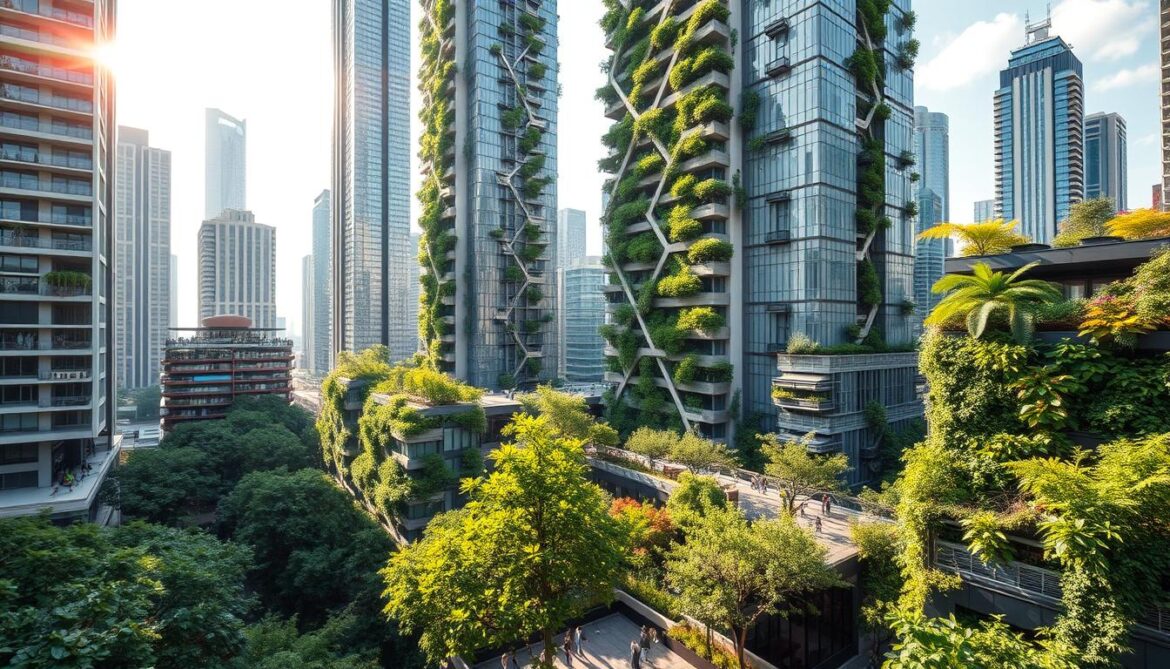
“The City of Copenhagen aims to plant 100,000 new trees within a decade as part of its greening initiative, and its 2015-2025 policy focuses on creating and improving the quality of urban nature in the city.”13
The integration of urban forestry, green infrastructure, and biophilic urbanism into the urban landscape is a complex undertaking, but one that promises significant benefits for public health, the environment, and the overall quality of life in cities. By addressing the challenges and adopting innovative solutions, cities can strive to create vibrant, sustainable, and nature-inclusive urban environments14.
Role of Landscape Architects in Urban Design
Landscape architects play a pivotal role in bridging the gap between urban development and environmental conservation. By collaborating closely with urban planners, they implement science-based frameworks to increase urban biodiversity and create more eco-friendly architecture15. Strategies like proper soil management and selecting pollinator-friendly vegetation can help capture and sequester carbon, while effectively managing water resources is crucial in the face of rising temperatures and extreme precipitation events15.
Collaboration with Urban Planners
The partnership between landscape architects and urban planners is essential in crafting sustainable urban designs15. Landscape architects work alongside urban planners to translate ecological research into deployable design and planning strategies, as seen in resources like the Making Nature’s City Toolkit15. This collaborative approach ensures that climate-resilient designs are implemented, promoting air quality improvement and mitigating heat island effects15.
Innovative Design Solutions
Landscape architects utilise innovative tools, such as the 14 Patterns of Biophilic Design, to create healthful human environments that acknowledge our innate biological connection to the natural world15. By incorporating green infrastructure solutions like shade systems and bioswales, they can reduce urban space temperatures by 10-12°C and effectively manage water resources15. These design approaches not only mitigate the impacts of climate change but also enhance community resilience and identity16.
“Landscape architects play a vital role in economic development by creating well-designed public spaces that attract visitors and promote commerce.”16
By integrating eco-friendly architecture, landscape urbanism, and biophilic urbanism principles, landscape architects are at the forefront of creating more sustainable and livable cities. Their collaborative efforts with urban planners and policymakers are essential in addressing the pressing challenges of climate change, biodiversity loss, and community resilience151617.
Community Engagement in Green Space Planning
Engaging communities in the planning process is fundamental to successful integration of community gardens, pocket parks, and other green spaces within sustainable cities. Involving residents in decision-making fosters a sense of ownership, connection, and pride in these green initiatives18. Communities become active participants in shaping and maintaining their urban green spaces, which can stimulate social interactions and increase social cohesion18.
Importance of Public Input
Incorporating public input in the early stages of urban planning ensures that green elements are woven into the fabric of the city, meeting the needs and preferences of local communities18. Factors like open park design, availability of sidewalks, functional playgrounds, and organised activities near urban green spaces may be associated with higher levels of social cohesion18. The engagement level within green spaces can vary based on qualities like access, amenities, intended use, and the social context of the area18.
Examples of Successful Engagement
Successful examples of community engagement include volunteer programmes for green space maintenance and public input sessions during the planning process19. Bryant Park in New York City experienced significant economic revitalisation and increased foot traffic after strategic urban design interventions that involved the local community19. Millennium Park in Chicago, which attracts millions of visitors annually, showcases the power of public-private partnerships in urban renewal projects19. Superkilen Park in Copenhagen incorporated elements from over 50 countries to represent the cultural backgrounds of its residents, demonstrating the value of community-centred design19.

“Engaging residents in decision-making fosters a sense of ownership, connection, and pride in green initiatives.”
The Future of Urban Green Spaces
As cities strive to become more climate-resilient and eco-friendly, the future of urban green spaces is set to undergo a remarkable transformation. Technological innovations are poised to revolutionise the way we design, maintain, and interact with nature within the urban landscape20.
Smart irrigation systems and eco-friendly construction materials will ensure the efficient and sustainable management of green infrastructure20. Vertical gardens and rooftop ecosystems will become increasingly prevalent, maximising limited urban space and contributing to improved air quality, biodiversity, and overall well-being20. Furthermore, the strategic placement of urban forests will create “green lungs” within the cityscape, promoting both physical and mental health for residents20.
The future of biophilic design in urban spaces is expected to witness an accelerated drive for sustainability, with a significant increase in policies promoting green construction20. Cities like Singapore have already set the standard, mandating greenery in building designs and creating stunning urban jungles that serve both recreational and ecological purposes20.
Predictions for Urban Environments
As the world becomes increasingly urbanised, the demand for green spaces within cities will continue to grow. Studies indicate that environments enriched with natural elements can reduce stress, boost creativity, and improve the overall quality of life in urban settings20. Exposure to plants and natural environments has been associated with improved cognitive functioning and emotional resilience in high-pressure urban environments20.
Moreover, integrating nature into urban spaces offers benefits that extend beyond visual appeal, leading to increased property values and enhanced tourism20. Individuals living near nature experience lower levels of anxiety, reduced rates of depression, and improved overall happiness, according to numerous studies on biophilic design20.
Technological Innovations in Green Design
The future of urban green spaces will be marked by a surge in technological innovations that support climate-resilient and eco-friendly design. Smart irrigation systems, advanced materials, and automated maintenance technologies will ensure the efficient and sustainable management of green infrastructure20. These advancements will enable cities to maximise the benefits of urban greenery while minimising the resources required for their upkeep.
As cities embrace the challenges of the future, the integration of nature and technology will be crucial in creating vibrant, livable, and resilient urban environments. By harnessing the power of innovation, urban planners and landscape architects can shape the cities of tomorrow, where climate-resilient, eco-friendly architecture and green infrastructure co-exist harmoniously202114.
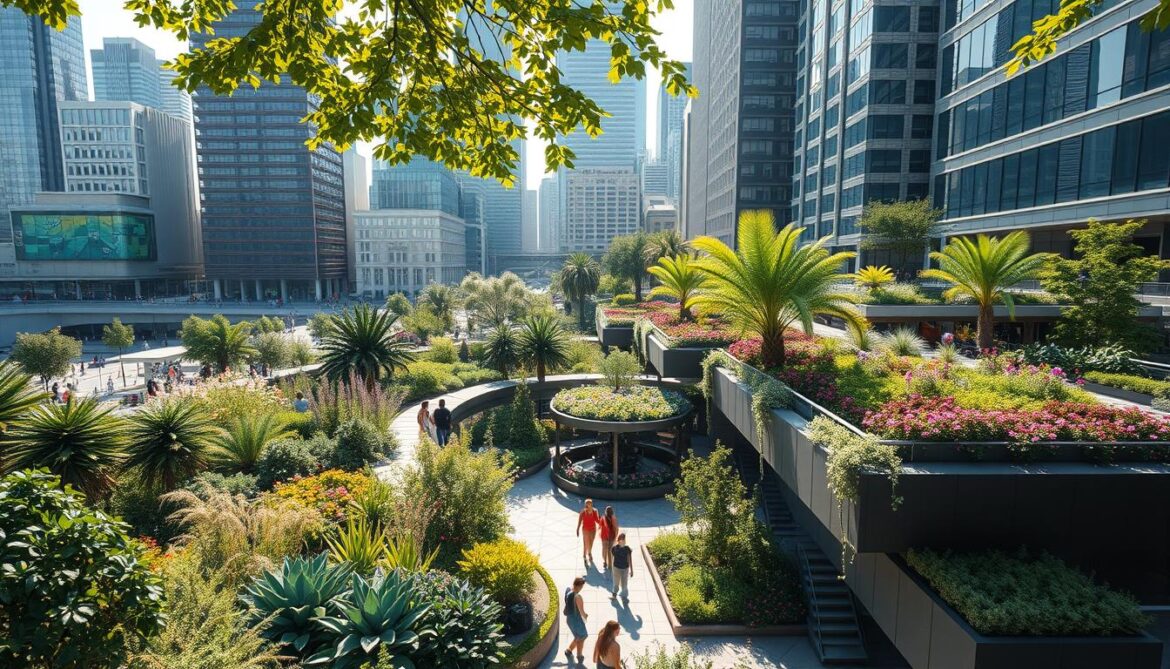
Policy and Regulation for Urban Green Spaces
As the world becomes increasingly urbanised, with over half of humanity now residing in cities22 and projections indicating that more than 70% of the population will live in urban areas by 205022, the importance of government support and effective policies for integrating green spaces into our cities has never been more crucial. Sustainable cities, urban forestry, and climate-resilient urban design are essential components of creating liveable, healthy, and environmentally-friendly metropolitan areas.
Importance of Government Support
Government support is pivotal in driving the successful implementation of urban green spaces. Effective policies can include mandatory green space allocations in new developments, incentives for green building practices, and regulations for biodiversity preservation in urban areas. These proactive measures can have a significant impact on the greening of our cities.
Examples of Effective Policies
Singapore’s extensive tree-planting initiative and carbon tax22 are excellent examples of government-led policies that have transformed the city-state into a lush, green metropolis. Similarly, New York City’s efforts to increase the share of native plant species through resources like the Native Species Planting Guide23 demonstrate how government support can drive meaningful change in urban green space development.
The table above highlights the significant disparity between the current green space per capita in Latin American and Caribbean cities (3.5 square meters)23 and the international standard of 9 square meters per person23. This underscores the urgent need for government-backed initiatives to increase urban green spaces in these regions.
“More than 300 professionals from 23 countries contributed to the report on urban greening in Latin America and the world, emphasizing the need for cooperation between local governments, communities, private sector, NGOs, and the international community for successful urban greening projects.”23
This quote from the report on urban greening in Latin America and the world23 emphasizes the collaborative approach required to create sustainable and climate-resilient cities. Governments must work closely with a diverse range of stakeholders to develop and implement effective policies that integrate nature into the urban fabric.
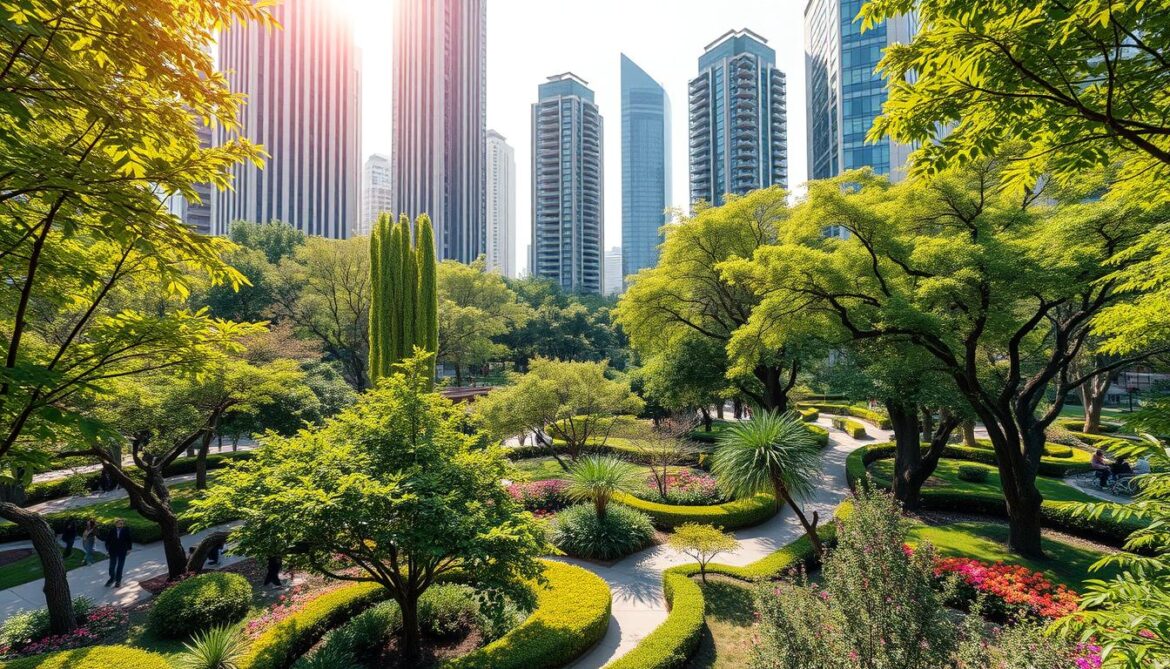
By embracing government-supported policies and regulations that prioritise urban green spaces, cities can pave the way towards a more sustainable and climate-resilient future. Integrating nature into the metropolis is not only an environmental necessity but also a crucial step towards enhancing the quality of life for urban dwellers.2223
Conclusion: Embracing Nature in Urban Living
The integration of green spaces into urban design is crucial for creating sustainable, resilient cities. This approach, supported by environmentalism, ecology, and concepts of sustainability, can lead to more liveable urban ecosystems that address environmental challenges, enhance biodiversity, and improve the quality of life for residents24. By incorporating biophilic design principles that emphasise the incorporation of natural elements, urban planners can foster a harmonious balance between human environments and the natural world24.
The Call for Green Space Initiatives
As the global population continues to urbanise, with two-thirds of the world’s population expected to live in cities by 205025, the need for thoughtful integration of green spaces into urban landscapes has never been more pressing25. Initiatives such as Singapore’s Garden City programme, which has significantly enhanced the city’s biodiversity and quality of urban life26, serve as inspiring examples of how green infrastructure can transform urban environments26.
Encouraging Local Action for Sustainable Cities
To create truly sustainable cities of the future, local community engagement and action are essential24. By empowering residents to participate in the planning and stewardship of urban green spaces, cities can foster a sense of environmental ownership and responsibility24. From community gardens to urban rewilding initiatives25, grassroots efforts that blend nature with the built environment can yield significant benefits, including improved mental and physical health, increased property values, and enhanced climate resilience25. Through collaborative, biophilic urbanism, cities can embrace nature and cultivate a more harmonious, sustainable future.
FAQ
What are urban green spaces?
Why are green spaces important in cities?
How do green spaces benefit the environment and city residents?
What are the key design principles for creating successful urban green spaces?
Can you provide examples of cities that have successfully integrated green spaces?
What are the challenges in blending green spaces with urban design?
How do landscape architects contribute to the integration of green spaces in cities?
What is the importance of community engagement in green space planning?
How might urban green spaces evolve in the future?
What is the role of government support in the development of urban green spaces?
Source Links
- How Outdoor Amenities Can Integrate Biophilia & Biodiversity – https://metropolismag.com/viewpoints/outdoor-amenities-biophilia-biodiversity/
- #Obj#99_0 – https://urbandesign.uchicago.edu/wp-content/uploads/2019/01/UGTransect-min.pdf
- Sustainable Cities: Integrating Biodiversity into Urban Design – https://constructive-voices.com/sustainable-cities-integrating-biodiversity-into-urban-design/
- Building with Nature: Integrating Green Spaces into Urban Construction – https://thursd.com/articles/integrating-green-spaces-into-urban-construction
- The Value of Incorporating Nature in Urban Infrastructure Planning – https://www.iisd.org/articles/insight/value-incorporating-nature-urban-infrastructure-planning
- Urban Architecture: Integrating Green Spaces in Cityscapes – WorldTeams – https://worldteams.com/blog/urban-architecture-integrating-green-spaces-in-cityscapes/
- Urban Development with a Green Touch: Building the Cities of Tomorrow – MIPIM World Blog – https://blog.mipimworld.com/guide-green-real-estate/green-real-estate-urban-development-green-touch/
- Enhancing Urban Spaces with Sustainable Design – https://bizforcenow.com/enhancing-urban-spaces-with-sustainable-design/
- Greening Milan: Innovating Urban Spaces Through Nature-based Solutions – https://interlace-hub.com/casestudy/30696
- Green Urbanism: Enhancing City Life Through Integrated Green Spaces – Premier Science – https://premierscience.com/pjes-24-363/
- Frontiers | An analysis of the effects of different urban park space environment construction on national health – https://www.frontiersin.org/journals/environmental-science/articles/10.3389/fenvs.2024.1433319/full
- Green Planning of Public Spaces: Integrating Nature in Urban Environments – Design Dash – https://designdash.com/2024/01/18/green-planning-of-public-spaces-integrating-nature-in-urban-environments/
- Urban Green Spaces: Combining Goals for Sustainability and Placemaking – https://www.europenowjournal.org/2021/05/10/urban-green-spaces-combining-goals-for-sustainability-and-placemaking/
- Green Spaces and Urban Development: A Healthy Balance – MIPIM World Blog – https://blog.mipimworld.com/guide-green-real-estate/green-real-estate-green-spaces-urban-development-balance/
- Green spaces matter – why Landscape Architecture is at the forefront of the fight against climate change | Design + Insights | Benoy – https://www.benoy.com/design-insights/green-spaces-matter-why-landscape-architecture-is-at-the-forefront-of-the-fight-against-climate-change/
- How Does Landscape Architecture Contribute to the Overall Sustainability and Resilience of Communities? – https://baselinecorp.com/landscape-design/how-does-landscape-architecture-contribute-to-the-overall-sustainability-and-resilience-of-communities/
- What is the role of landscape architects in designing cities – https://www.re-thinkingthefuture.com/city-and-architecture/a3493-what-is-the-role-of-landscape-architects-in-designing-cities/
- The Relationship between Social Cohesion and Urban Green Space: An Avenue for Health Promotion – https://pmc.ncbi.nlm.nih.gov/articles/PMC6388234/
- 10 Case Studies For Community-Centered Public Parks – https://urbandesignlab.in/10-case-studies-for-community-centered-public-parks/?srsltid=AfmBOoq0aDpTQM21HmTiKPyQuMtT52UwyvpGC4WCuxMfXSm8UjmGYQJI
- The Rise of Biophilic Design: Integrating Nature into Urban Spaces – https://www.lorddecor.com/blog/the-rise-of-biophilic-design-integrating-nature-into-urban-spaces
- The Urban Playground: Designing for Joy, Resilience, and Health in Our Cities – Land8 – https://land8.com/the-urban-playground-designing-for-joy-resilience-and-health-in-our-cities/
- PDF – https://www.thegpsc.org/sites/gpsc/files/final_urban_nature_and_biodiversity_for_cities.pdf
- Good Practices for Urban Greening – https://publications.iadb.org/publications/english/document/Good-Practices-for-Urban-Greening.pdf
- The actuality of ever-growing cities makes the need for green spaces and nature within urban areas… – https://medium.com/the-storm-of-words-un-said/the-actuality-of-ever-growing-cities-makes-the-need-for-green-spaces-and-nature-within-urban-areas-8e91b6ed665d
- Rewilding Cities: Why it’s needed and how you can help – https://www.mossy.earth/rewilding-knowledge/rewilding-cities
- Integrating Nature into Urban Areas: The Rise of Forest Estates and Forest Cities – https://www.linkedin.com/pulse/integrating-nature-urban-areas-rise-forest-estates-cities-ronald-mbiu-lf7xf






